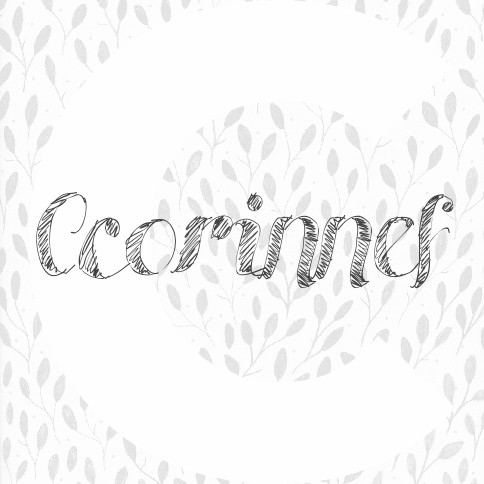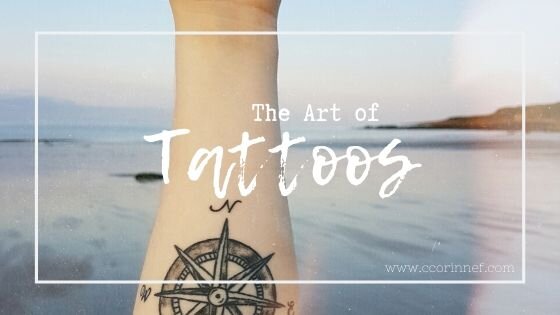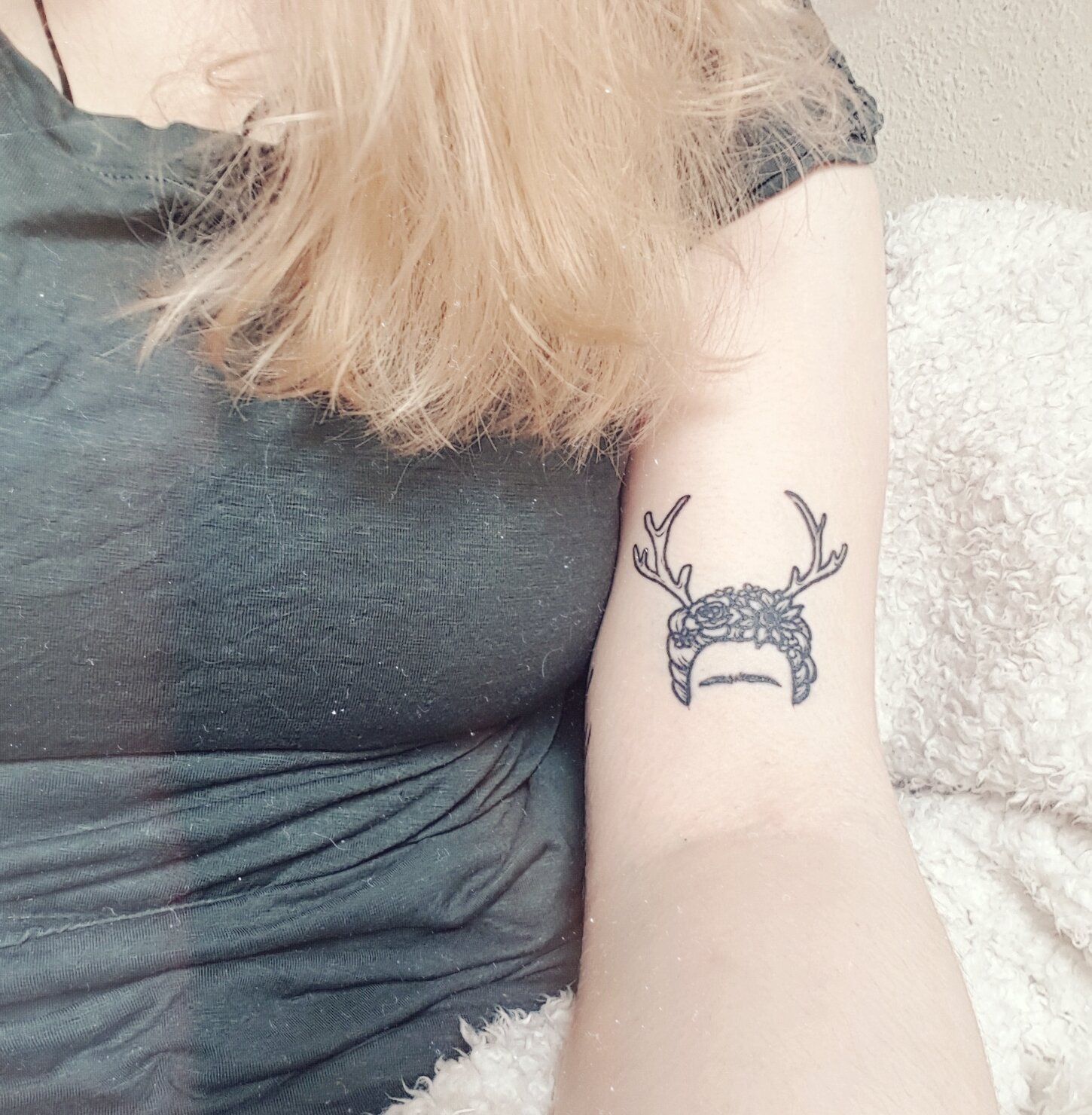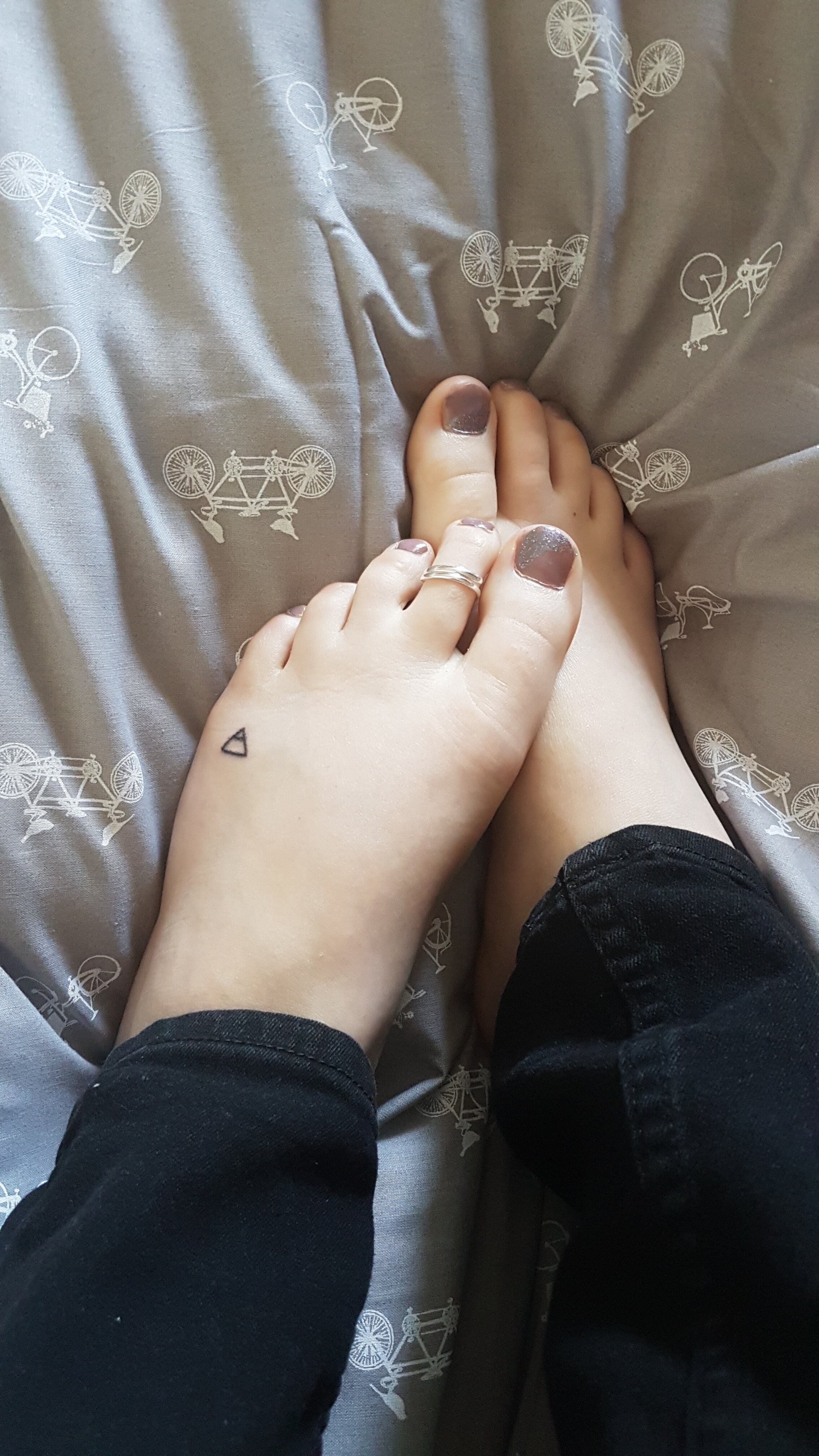Tattoos have existed for millennia. Currently, the oldest known tattoos are from the Alps mountains on Ötzi which date from 3250BC and the oldest known decorative tattoos are from Egypt dating to 3351 - 3017BCE. They existed as a form of magic or medicine or branding for slaves and criminals, before becoming a form of identity, expression and artwork. Since around the 1800's, though, tattoos have been increasing in sophistication, design, artform and popularity. Tattoos are now incredibly popular and probably every city in the world has at least one, if not many more, tattoo shops and artists. Tattooing was by no means 'discovered' by white people but since the practice had been through phases of popularity in Europe, they were quick to forget and quick to become fascinated by tattoos. Following the age of colonialism and ideas of European superiority, tattoos were often labelled as barbaric or primitive and were used as a way to further discriminate against people in 'discovered' lands. A really surprising fact that I discovered while researching this topic was that in Latin the word used to refer to tattoos was 'stigmata' which is also the root word for stigmatise, tattoos often literally were symbols of stigmas.
Tattoos Through Ancient History
One of the most common misconceptions in the history of tattooing is that tattoos were brought back to the UK and the West on the Cook voyages of the 1790s. As can be seen from tattooed mummies across the globe and dating from across almost the entire history of humanity, tattooing as a practice has been recurrent. Whatever the context or purpose of the tattoo, whether for identity, medicine, status, religion, or whatever tattoos have been used across many cultures and times. The cook voyages simply brought back the word tattoo - from the Polynesian tatau or tatu. Before Cook's journeys introduced this word tattooing was known as 'painting' 'scarring' 'staining' stitching' and a host of other words were used to describe the practice. Tattoos have been used as a means of identifying people and animals, along with branding, for centuries: facial tattoos to denote punishment for crimes or to indicate status as a slave were used in the Chinese Zhou and Roman Empire time periods - until Emperor Constantine banned the practice of facial tattoos in AD330 and the Second Council of Nicaea banned all tattooing as 'pagan' in AD787. Runaway slaves were commonly tattooed on their face with 'FUG' for fugitive. In ancient Egypt there is evidence of medical tattooing first 'discovered' by Daniel Fouquet in 1898. He found mummies with tattoos and scarification which didn't appear to be decorative and speculated that they were "an established treatment for a condition of the pelvis, very probably chronic pelvic peritonitis."
The negative European influence on the Maori population of New Zealand first started with trading for moko tattoos, which were acquired by Maori people hunting and decapitating each other, and later by imposed Christian values by missionaries who discouraged and disliked the tattooing practice, something that has been repeated the world over. Tattooing was practiced widely in the Austronesian region, thought to have been developed before 1500BCE. 'Needles' were commonly made from Citrus thorns, fish bone, bone and oyster shells. Other ethnolinguistic groups who observed a practice of tattooing include the Ainu of Japan, some Austroasians of Indochina, Berber women of Tamazgha, Yoruba, Fulani and Hausa of Nigeria, Pre-Columbian Native Americans, and Iron Age British Picts.
Throughout history from around the 1500s to 1900s many many people were kidnapped or tricked into travelling back to Europe by early explorers and were often presented at the royal court or put on display as 'curiosities' to be gawked at, especially if they had tattoos across their bodies. Many of these are terribly sad stories of exploitation by white Europeans and often end in death by being exposed to illnesses their immune systems could not handle. "In 1565, French sailors abducted from Canada an Inuit woman with facial tattoos and her daughter. They put them on public display in Antwerp, the Netherlands, drawing crowds for money. Sir Martin Frobisher, an English privateer, also abducted an Inuit man from Baffin Island, putting him on display in London before he died from European diseases. Frobisher returned to Baffin Island and abducted a man, a woman, and a child, also taking them back to London for public display. They also died from illness shortly afterwards." William Dampier, a member and financier of Captain Cook's famous voyages bought a slave called Jeoly from Miangas Island in 1690. Jeoly, nicknamed the 'painted prince' was put on display across Europe and Dampier described his tattoos as covering most of his body with a 'great variety of lines, flourishes, chequered-work, &c.'
Tattoos Through Cultural Context
The methods of tattooing are varied and extensive, but they all involve puncturing the skin to insert a pigment into the epidermis where it remains trapped as the body heals the wound. Some cultures created tattoos by fashioning 'needles' out of shell or bone and creating lines by joining punctured dots of pigment together. Some cultures cut the design into the skin first and then rubbed the pigment into the wound. Today, the tattoo machine is most commonly used to insert pigment into the skin which utilises modern hygiene methods to reduce the risk of infection.
Among men of Austronesian societies, such as the Ifugao and Dayak, tattooing was an integral part of head-hunting culture where they served as a record of the number of kills a warrior had done in battle. Tattoos were also used in initiation rites into adulthood across Austronesia. A warrior's status was inscribed into his skin; the design, placement and number of tattoos indicated prowess and success in battle. Among Austronesian women, facial tattoos denoted status, skill and beauty and were often used as a symbol that a girl had reached marriageable age. Among Visayans of the Phillipines, tattoos were worn by nobility and warriors as records success in mangayaw raids.
Tattoos were also commonly used across the globe as magical wards against dangerous spirits or illnesses. Among the Ainu of Japan, who have mythology of tattooing practice coming from the sister of the creator god, Turesh Machi, and who faced much persecution by the Japanese authorities for continuing this culturally significant practice, tattoos were believed to stop evil spirits from entering the body and causing illness or misfortune. They also had specific tattoos placed around the body to serve as charms against illness and disease. Tattoos were used by Ancient Egyptians to depict dedication to a God and protection from evils. As Vanishing Tattoo states, "Largely administered by holy monks, sagacious tribal elders, and layman tattooists, the esoteric art was not only believed to provide its wearers with indelible protection from a variety of misfortunes, but also the mystical power to influence other peoples’ behaviour, carry the deceased safely into the afterlife, or simply increase a person’s 'luck.'" It could also be argued that the Catholic Croats in Bosnia tattooed women and children to protect them against a perceived 'evil', that of conversion to Islam during the Ottoman rule.
Native Americans, such as Seminole, Cherokee, Cree, Yurok, Tolowa, Hupa, Chimariko and Creek, used tattooing as a form of identity and belonging to their tribe. Obviously there is a huge range of cultural differences between each Native American community: the Cree had men covered entirely with tattoos while restricting women to only three or four lines on the face; for the Yurok tattooing was more popular among the women than the men, where a woman's age would be indicated by a line tattooed on the chin roughly every five years. Some communities even had tattooed size guides for seashells which were used as a form of currency. The Yuma used tattoos to denote status and community as well as to decorate warriors to appear more fierce - "they believed access to the afterlife would be denied to those who wore no tattoos."
Because tattoos were used to mark criminals and slaves, tattoos themselves, and by extension the people who have them, often face stigma and discrimination - the ink in their skin being culturally associated with criminality and deviance for centuries. In many cases, tattoos are considered an integral part of gang and mafia culture - often specific images and words are used to indicate membership and allegiance. Since the 60s and 70s tattoos have also been associated with social outcast groups such as bikers and prisoners, which has further played into the stereotypes of people with tattoos. Many prison inmates still tattoo themselves today, using whatever materials they can get their hands on. In China, tattoos are still considered taboo. The association between criminals and tattoos was a huge influence on this. Criminals were often tattooed to mark them and ostracise them from society. In Japan, tattoos were outlawed in the 19th Century by the Meiji Government - this wasn't repealed until 1948. In the city of Osaka employees are forbidden from getting new tattoos and all pre-existing tattoos are required to be covered completely, or removed. There is a strong and prevailing cultural link in Japan between tattoos and organised crime, yakuza. A project by Fukushi Masaichi's tattoo association was undertaken to collect and preserve the tattooed skins of dead Japanese people. A similar project to promote the art of tattoos was an exhibition by the Museum of Croydon called Beyond Skin.
Tattoos are often used symbolically to represent everything from a loved one, to a favourite sport, to prison sentences. For example, the teardrop tattoo has been said to represent murders committed or the death of a friend. US military personnel have an equally symbolic use of tattoos to mark identity, membership of particular regiments, battles participated in, murders and loved ones. Many companies now are trying to promote diversity and inclusion in employees, and many people are seeing less discrimination based on tattoos and their negative stereotypes.
Many different religions have expressed as many different viewpoints and levels of acceptance or tolerance towards tattoos - some completely prohibit their followers from getting tattoos, such as some Jewish traditions and Sunni Islam, while others, such as Hinduism and Neopaganism, show acceptance. Others still, such as Christianity remain undecided and some religions like Buddhism incorporate tattoos into their spiritual practice, known as sak yant.
Tattoos Through the 19th and 20th Centuries
Tattoos have been used administratively as a very literal form of identity. In 18th Century Thailand, tattoos were used to denote administrative identity - army officers, couriers, grass cutters, slaves and criminals all had distinctly unique tattoo designs and placements to denote their profession and to distinguish themselves from other departments. There were even different tattoos for corvée exemption due to illness or old age. As is commonly known, tattoos were used by the Nazi's in Auschwitz to identify registered prisoners with a complex numerical system. Many people alive today still bear this mark of their horror and trauma from life under the Nazi's. The SS were also tattooed with their blood group in WW2 to aid in any necessary medical treatment. Many SS members later shot themselves in the arm so as to remove the very identifying symbol of their Nazi involvement.
In Britain the first person to define their profession as 'tattoo artist' was Sutherland MacDonald in London in 1894. Prior to the 1870s tattoos were still very much associated with the 'lower classes' i.e. criminals and sailors, however the practice was soon coveted by the wealthy upper classes of Britain. Many of the royal family sported tattoos as a symbol of their wealth and style - since tattooing in the late 1800s was still a very time consuming and expensive practice. The invention in 1891 by Samuel O'Reilly of the tattoo machine, an adaptation of Thomas Edison's electric pen machine, meant that tattoos became cheaper and easier to produce so the practice dropped out of fashion among wealthier citizens. Tattoo art didn't really become considered as a legitimate career choice until the 1980s. More than 5000 people declared 'tattoo artist' as their professional title when in 1975 there had only been 40. In Australia, Fred Harris was considered the only tattoo artist in Sydney between 1916 and 1943. Throughout Harris' career, he tattooed mostly sailors but he also saw a trend of women getting their legs tattooed so the designs could be seen through their stockings. Throughout the 20th Century there is evidence of women getting tattoos, often ones that could be hidden well under clothing. There are even records of a female tattoo artist from the 1920s called Jessie Knight. An interesting exhibition which really put her work and career on display was held in Cornwall in the Maritime Museum.
The use of tattoos as a distinguishing identification feature was established in the 1800s as part of the 'protection papers' as a way for American sailors to avoid being impressed to the British royal navy. Prior to the use of tattoos as identification in the papers, the descriptions of the named individuals were too generic and often not accepted by British Captains. "In the late eighteenth and early nineteenth centuries, tattoos were as much about self-expression as they were about having a unique way to identify a sailor's body should he be lost at sea or impressed by the British navy." Until the onset of World War One there was a huge demand by sailors, usually British and American, for tattoo artists in ports across the world. This demand was addressed by the the first recorded professional tattoo artist German born Martin Hildebrandt who opened a shop in New York City in 1846. His career mostly consisted of travelling between camps of soldiers in the American Civil War. Following the 1960s and 70s there was a marked increase in bikers' groups and tattooing became a strong marker of identity for these groups - similar to other groups like gangs and prisoners.
Tattoos Today
In 2006 the results of a survey by the Journal of the American Academy of Dermatology found that 36% of Americans aged 18-29, 24% of 30-40 year olds and 15% of Americans who were 41-51 had a tattoo. A similar survey by the Pew Research Centre found that 40% of Americans aged 26-40 had a tattoo. "They concluded that Generation X and Millennials express themselves through their appearance, and tattoos are a popular form of self-expression." Tattoos have even been used as the basis for, and advertisement of, logo designs. For example, Macy's logo is based off of a tattoo that the founder had on his hand. The practice of "skinvertising" has been used by brands such as HBO, Red Bull, ASOS and Sailor Jerry's.
Growing popularity can be seen for permanent makeup tattoos and for artistic tattoos to be used to cover up scars, such as from mastectomy, and perceived imperfections, like stretch marks. There is also high popularity for tattooing nipples after breast reconstruction following mastectomy. Permanent makeup includes tattooing pigment on eyebrows, lips and eyes - usually done with very natural colour shades to enhance a persons appearance. More recently, there has been a marked increase in the trend of 'stick and poke' or 'DIY' tattoos - with a few companies even offering complete kits to ensure hygienic practice. There is a motive for girls and women with low self-esteem and negative body feelings to get tattoos as a way to reclaim control of their bodies and search for their own identities. The increase of women getting tattoos, especially visible tattoos, is helping to change the stereotypes and stigmas associated with tattoos. Beverly Yuen Thompson interviewed many women across America in 'Covered in Ink' to look at the interaction between reactions to tattooed women in the general public and within families. She found that younger generations tend to be more accepting and generally unbothered by other's tattoos as compared to their older counterparts. Within family units, the reactions that women faced after getting a tattoo ranged from acceptance to disowning. Thompson noticed a correlation between the existing familial relationship and the post-tattoo reaction - those that were emotionally accepting of their female relatives were able to maintain close relationships despite a personal dislike to inked art.
In 2006 the results of a survey by the Journal of the American Academy of Dermatology found that 36% of Americans aged 18-29, 24% of 30-40 year olds and 15% of Americans who were 41-51 had a tattoo. A similar survey by the Pew Research Centre found that 40% of Americans aged 26-40 had a tattoo. "They concluded that Generation X and Millennials express themselves through their appearance, and tattoos are a popular form of self-expression." (wiki/tattoo) Tattoos have even been used as the basis for, and advertisement of, logo designs. For example, Macy's logo is based off of a tattoo that the founder had on his hand. The practice of "skinvertising" has been used by brands such as HBO, Red Bull, ASOS and Sailor Jerry's.




